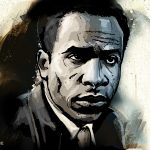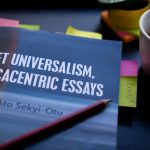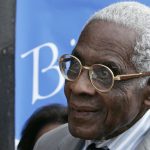Frantz Fanon and the question of praxis
For the university-trained intellectual, Fanon poses a simple demand: to move to a praxis with ‘a mutual current of enlightenment and enrichment’ between protagonists from different social location…
Author:
21 April 2020

This is an edited excerpt from Frantz Fanon: The Brightness of Metal, the 26th Dossier published by the Tricontinental: Institute for Social Research.
In June 1959, Frantz Fanon suffered serious injuries when a jeep he was travelling on was blown up by a mine near the Tunisian and Algerian border. He was sent to Rome for medical treatment, where he narrowly escaped assassination, most likely at the hands of a violent settler organisation linked to the French state.
In March 1960, Fanon was sent to Accra to become a roving ambassador for the Provisional Government of the Algerian national liberation movement, the Front de libération nationale (“National Liberation Front”). His encounters with newly independent states were frequently dispiriting. In November 1960, he was part of a team tasked with a reconnaissance mission aimed at opening a southern front on the border with Mali, with supply lines running from Bamako across the Sahara. At the last minute, suspecting a trap, they abandoned their plan to travel by air and drove the 2 000km from Monrovia to Bamako. The plane on which they had been scheduled to travel was diverted to Abidjan, where it was searched by the French military.
In his logbook, Fanon recorded his concern with the limits of forms of politics that fail to reach beyond the Manichaeism introduced by colonialism and to develop emancipatory ideas and practices: “Colonialism and its derivatives do not, as a matter of fact, constitute the present enemies of Africa. In a short time this continent will be liberated. For my part, the deeper I enter into the cultures and the political circles the surer I am that the great danger that threatens Africa is the absence of ideology.”
Moved by the vast desert vistas, and returning to the poeticism of his early work, Fanon wrote that: “Some days ago we saw a sunset that turned the robe of heaven a bright violet. Today it is a very hard red that the eye encounters.” Though the trip across the desert had left him visibly exhausted, he immediately went to Accra to write a contribution to an English-language publication by the Provisional Government of Algeria. An examination by a doctor in Accra raised the possibility of leukaemia. He returned to Tunis, took a blood test, and diagnosed himself with leukaemia. That evening, he announced his resolve to write a new book. After receiving treatment in a clinic outside of Moscow, he had a brief window of opportunity to write as the cancer went into remission.
The Damned of the Earth
Parts of Fanon’s last work, The Damned of the Earth, were dictated from a mattress on the floor of a flat in Tunis as he was dying. The book offers a searing indictment of settler colonialism, a critical account of the struggle against colonialism, an equally searing account of the postcolonial morass and a radically democratic vision of emancipatory praxis. It ends with a harrowing account of the damage wrought by the violence of colonial war.
The critique of the colonial city in the book’s opening pages is particularly powerful and continues to resonate into the present. The Manichean ideology that Fanon critiqued in his early work written in France took on a concrete material form in the settler colony, of which apartheid was a paradigmatic case. The colonial world is divided into different zones, intended for different kinds of people. It is a world “of barbed wire entanglements”, “a world divided into compartments”, “a world cut in two”, “a narrow world strewn with violence”. In Fanon’s view, authentic decolonisation requires a decisive end to a situation in which “this world divided into compartments, this world cut in two is inhabited by different species”.
Related article:
In Fanon’s narrative, the initial response to colonial oppression is fundamentally shaped by what it opposes: “[T]he Manichaeism of the coloniser produces a Manichaeism of the colonised.” Fanon is clear about the costs of this counter-Manicheanism: “To the lie of the colonial situation the colonised replies with an equal lie.” Within the struggle there is, he says, an initial “brutality of thought and mistrust of subtlety”.
But, as there is movement along what Fanon calls “the weary road to rational knowledge”, colonial paradigms are transcended rather than merely inverted. The people begin “to pass from total, indiscriminating nationalism to social and economic awareness”. Fanon is clear that this process requires that “the people must also give up their too-simple conception of their overlords” as “the racial and racist standard of judgment is transcended”.
Ato Sekyi-Otu, making a point that is crucial for enabling serious readings of the work, shows that a set of emphatic statements offered as definitive statements at the beginning of the book are later challenged as Fanon’s narrative unfolds. To take just one instance, in the beginning it is asserted that: “Truth is that which hurries on the break-up of the colonial regime; it is that which promotes the emergence of the nation; it is all that protects the indigenous people and ruins the foreigners.” Later on, Fanon explains that – as it becomes clear that “exploitation can wear a black face, or an Arab one” – initial certainties run into obvious limits.
Related article:
Fanon writes that, as the Manichean certainties that mark the first moment of struggle begin to break down, “the idyllic and unreal clarity of the beginning is followed by a semi-darkness that bewilders consciousness”. Over time, as the struggle develops, “consciousness slowly dawns upon truths that are only partial, limited and unstable”. Things are rethought in the light of the experience of struggle, of collective motion, against colonialism. The fundamental purpose of Fanon’s account of this move out of the Manichean logic of colonialism is, Sekyi-Otu argues, “to stage the upsurge of richer modes of reasoning, judging and acting” than those immediately accessible within the limits of colonial thought.
Fanon had witnessed the first years of the African Thermidor, the moment when, as he explains, the “liberating lava” of the great anti-colonial struggles was cooled as the people were expelled from history, “sent back to their caves” by leaders who, “instead of welcoming the expression of popular discontentment” and the “free flow of ideas”, took it on themselves to “proclaim that the vocation of their people is to obey and to go on obeying”. In his last book, he was clear that holding to principle meant undertaking a struggle within the struggle, as well as confronting the colonial enemy. He warns that “an unceasing battle must be waged, a battle to prevent the party from ever becoming a willing tool in the hands of a leader”. Fanon argues that, in order to set the rebellion on a rational foundation, it is necessary to resist “those inside the movement who tend to think that shades of meaning constitute dangers” and leaders who insist that “the only worthwhile dogma … is the unity of the nation against colonialism”.
Related article:
His critique of the national bourgeoisie, “the rapacious bourgeoisie”, their use of the state as an instrument to prey on society, and their misuse of the history of collective struggle to shore up their own authority is unsparing. Fanon is clear that there are forms of nationalist militancy that hold “the same unfavourable judgments” about the most oppressed among the colonised that are held by the colonisers. He insists that national consciousness – “that magnificent song that made the people rise against their oppressors” – must be supplemented with political and social consciousness.
Fanon issues a clear warning about parties aiming to “erect a framework around the people that follows an a priori schedule” and intellectuals deciding to “come down into the common paths of real life” with formulas that are “sterile in the extreme”. For Fanon, the vocation of the militant intellectual is to be in the “zone of occult instability where the people dwell”, in the “seething pot out of which the learning of the future will emerge”, and, there, to “collaborate on the physical plane”. He is clear that the university-trained intellectual must avoid both the inability to “carry on a two-sided discussion”, to engage in genuine dialogue, and its obverse, becoming “a sort of yes man who nods assent at every word coming from the people”. Against this, he recommends “the inclusion of the intellectual in the upward surge of the masses” with a view toward achieving “a mutual current of enlightenment and enrichment”.
Fanon affirms the practice of mutuality rooted in an immediate commitment to radical equality, something like Marx’s youthful vision of “an association of free human beings who educate one another”. His consistent commitment to the recognition of “the open door of every consciousness” brings him to a radically democratic understanding of struggle rooted in local practices in which dignity is affirmed, discussion carried out and decisions taken. For Fanon, the primary task of political education is to show that “there is no famous man who will take the responsibility for everything, but that the demiurge is the people themselves and the magic hands are finally only the hands of the people”. He affirms the importance of “the free exchange of ideas which have been elaborated according to the real needs of the mass of the people”. There are clear resonances with CLR James’ famous assertion that, in a phrase borrowed from Vladimir Lenin, “every cook can govern”. Fanon, committed until the end to the emancipation of reason, to its emancipation in and via struggle, ended his last book with the imperative to “work out new concepts”.
Radical reason
For Fanon, the development of radical reason – which is to say emancipatory reason – certainly includes conversation with philosophy as it is defined by Paulin Hountondji: “not a system but a history”. But, the plane of becoming on which this work constitutes itself is, not unlike Antonio Gramsci’s philosophy of praxis, that of struggle – the struggles of the damned of the earth. Fanon is, in Gramsci’s terms, a democratic philosopher. “This philosopher,” Peter Thomas writes, “is no longer defined in terms of separation from the ‘life of the people’, but as an expressive element of that life which it aims to cultivate, increasing its capacity for active relations of knowledge and practice.”
For the university-trained intellectual, Fanon poses a simple demand, but one that retains its radical charge almost 60 years later: to move beyond the ontological and spatial ordering of oppression and commit to a form of insurgent and democratic praxis in which “a mutual current of enlightenment and enrichment” is developed between protagonists from different social locations.
Fanon’s last book, Les Damnés de la Terre, arrived in the world shortly after he left it. In 1963 it was mistranslated into English as The Wretched of the Earth. Paulo Freire was one of the first major intellectuals to understand Fanon’s theory of praxis. In 1968, Freire was finishing the manuscript of his second book, Pedagogy of the Oppressed, in Santiago while living in exile from the military dictatorship in Brazil. In an interview in California in 1987, he recalled: “A young man who was in Santiago on a political task gave me the book The Wretched of the Earth. I was writing Pedagogy of the Oppressed, and the book was almost finished when I read Fanon. I had to rewrite the book.”
Related article:
After reading Fanon, Freire developed a radical humanism committed to the immediate recognition of the full and equal personhood of the oppressed as a pre-condition for emancipatory action. Like Fanon, his form of praxis is predicated on an ethic of mutuality between the authorised intellectual and people who have not had access to much formal education.
Pedagogy of the Oppressed was published later that year and, in 1972, it was taken up by the South African Students’ Organisation (Saso), which had been formed by Steve Biko, Barney Pityana, Rubin Phillip and others in 1968. Beginning in Durban, Freirean ideas became central to a form of radically democratic action that aimed to work towards critical consciousness as a shared project, rather than to announce new versions of what Marx had called “dogmatic abstraction” to the people.
Related article:
In the late 1970s, and through the 1980s, Freirean ideas about praxis – shaped to a significant extent by Fanon, and in many cases read together with Fanon – were central to the political work undertaken in workplace and community struggles across South Africa. Freire’s theory of praxis enabled the emergence of some of the most impressive and powerful social forces on the planet at the time, in which ordinary people became central protagonists in struggle, and in the making of meaning, counter-power and history from below.
In contemporary South Africa, Fanon is read and discussed from the political education workshop organised on a hard-won urban land occupation to the trade union political school to the academy, in both its dissident spaces and in its highest reaches. Fanon’s life and work offer inspiration as well as analytical acuity to all of these audiences.
Achille Mbembe, writing from Johannesburg, explains that: “I myself have been attracted to Fanon’s name and voice because both have the brightness of metal. His is a metamorphic thought, animated by an indestructible will to live. What gives this metallic thinking its force and power is the air of indestructibility and, its corollary, the injunction to stand up. It is the inexhaustible silo of humanity that it houses and which, yesterday, gave the colonised strength and which, today, allows us to look forward to the future.”





